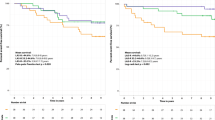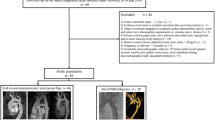Abstract
Background
Non-invasive imaging markers in patients with repaired tetralogy of Fallot (rTOF) are still being investigated to inform clinical decision making. Atrial function is a prognostic indicator in many acquired and congenital heart diseases. We sought to examine the relationship between cardiac MRI (CMR)-derived indices of left atrial (LA) function, native left ventricular (LV) T1 values, biventricular systolic function, and exercise capacity in rTOF.
Methods
Sixty-six patients with rTOF without prior pulmonary valve replacement who underwent CMR (median age 18.5 years) were identified. Twenty-one adult rTOF patients (age range 19–32 years) were compared with 20 age-matched healthy volunteers (age range 19–34 years). LA reservoir, conduit, and pump global longitudinal strain (GLS) and strain rate (SR) were determined by tissue tracking. Native LV T1 values were measured on rTOF patients. Pearson correlations were performed to determine bivariate associations.
Results
Adult rTOF patients had higher pump GLS, pump:conduit, and pump:reservoir GLS ratios, and lower conduit:reservoir GLS ratio, LV ejection fraction (EF), and right ventricular EF compared to controls (p < 0.001 for each comparison). LA conduit:reservoir GLS and pump:reservoir GLS had correlations to native LV T1 (ρ = 0.26, p = 0.03 and ρ = − 0.26, p = 0.03, respectively). LA reservoir SR had positive correlation to RV EF (ρ = 0.27, p = 0.03). There were no statistically significant correlations between LA function and exercise capacity.
Conclusions
LA function is altered in adolescent and young adult patients with rTOF indicating worse diastolic function and relates to increasing native LV T1 values. Future studies are indicated to investigate the progression of adverse atrial-ventricular interactions and poor outcomes in this population.

Similar content being viewed by others
Data Availability
Can be made available upon receipt of a reasonable request.
References
Marelli AJ et al (2014) Lifetime prevalence of congenital heart disease in the general population from 2000 to 2010. Circulation 130(9):749–756
Tretter JT et al (2016) Defining and refining indications for transcatheter pulmonary valve replacement in patients with repaired tetralogy of Fallot: contributions from anatomical and functional imaging. Int J Cardiol 221:916–925
Geva T et al (2018) Preoperative predictors of death and sustained ventricular tachycardia after pulmonary valve replacement in patients with repaired tetralogy of Fallot enrolled in the INDICATOR cohort. Circulation 138(19):2106–2115
Tretter JT, Redington AN (2018) The forgotten ventricle? The left ventricle in right-sided congenital heart disease. CircCardiovasc Imaging 11(3):e007410
Tretter JT, Redington AN (2018) Risk factors and biomarkers of poor outcomes: time to throw out right ventricular volumes in repaired tetralogy of Fallot? Lessons from the INDICATOR cohort. Circulation 138(19):2116–2118
Geva T et al (2004) Factors associated with impaired clinical status in long-term survivors of tetralogy of Fallot repair evaluated by magnetic resonance imaging. J Am Coll Cardiol 43(6):1068–1074
Tweddell JS et al (2012) Timing and technique of pulmonary valve replacement in the patient with tetralogy of Fallot. SeminThoracCardiovascSurg 15(1):27–33
Khairy P et al (2008) Implantable cardioverter-defibrillators in tetralogy of Fallot. Circulation 117(3):363–370
Ta HT et al (2020) Atrial function and its role in the non-invasive evaluation of diastolic function in congenital heart disease. PediatrCardiol 41(4):654–668
Thomas L et al (2019) Left atrial structure and function, and left ventricular diastolic dysfunction: JACC state-of-the-art review. J Am Coll Cardiol 73(15):1961–1977
Luijnenburg SE et al (2013) Abnormal right atrial and right ventricular diastolic function relate to impaired clinical condition in patients operated for tetralogy of Fallot. Int J Cardiol 167(3):833–839
Koenigstein K et al (2013) Altered diastolic left atrial and ventricular performance in asymptomatic patients after repair of tetralogy of Fallot. PediatrCardiol 34(4):948–953
Kutty S et al (2017) Abnormal right atrial performance in repaired tetralogy of Fallot: a CMR feature tracking analysis. Int J Cardiol 248:136–142
van der Geest RJ et al (1997) Comparison between manual and semiautomated analysis of left ventricular volume parameters from short-axis MR images. J Comput Assist Tomogr 21(5):756–765
van der Geest RJ, Reiber JH (1999) Quantification in cardiac MRI. J MagnReson Imaging 10(5):602–608
Critser PJ et al (2021) Cardiac magnetic resonance derived atrial function in patients with a Fontan circulation. Int J Cardiovasc Imaging 37(1):275–284
Truong VT et al (2020) Normal left atrial strain and strain rate using cardiac magnetic resonance feature tracking in healthy volunteers. Eur Heart J Cardiovasc Imaging 21(4):446–453
Wasserman KHJ, Sue DY, Casaburi R, Whipp BJ (1999) Principles of exercise testing and interpretation: including pathophysiology and clinical applications, 3rd edn. Lippincott, Williams & Wilkins, Philadelphia
Cooper DM et al (1984) Aerobic parameters of exercise as a function of body size during growth in children. J ApplPhysiol 56(3):628–634
Powell AW et al (2020) The unique clinical phenotype and exercise adaptation of Fontan patients with normal exercise capacity. Can J Cardiol 36(9):1499–1507
Geva T (2013) Indications for pulmonary valve replacement in repaired tetralogy of fallot: the quest continues. Circulation 128(17):1855–1857
Hoit BD (2014) Left atrial size and function: role in prognosis. J Am Coll Cardiol 63(6):493–505
Hou J et al (2015) Atrial mechanics after surgical repair of tetralogy of Fallot. Echocardiography 32(1):126–134
Abd El Rahman M et al (2015) Assessment of inter-atrial, inter-ventricular, and atrio-ventricular interactions in tetralogy of Fallot patients after surgical correction. Insights from two-dimensional speckle tracking and three-dimensional echocardiography. Cardiol Young 25(7):1254–1262
Menon SC, Kaza AK, Puchalski MD (2012) Effect of ventricular size and function on exercise performance and the electrocardiogram in repaired tetralogy of Fallot with pure pulmonary regurgitation. Ann PediatrCardiol 5(2):151–155
Rashid I et al (2020) Right ventricular systolic dysfunction but not dilatation correlates with prognostically significant reductions in exercise capacity in repaired Tetralogy of Fallot. Eur Heart J Cardiovasc Imaging 21(8):906–913
Schwartz MC et al (2012) Relation of left ventricular end diastolic pressure to right ventricular end diastolic volume after operative treatment of tetralogy of fallot. Am J Cardiol 109(3):417–422
Haaf P et al (2016) Cardiac T1 Mapping and Extracellular Volume (ECV) in clinical practice: a comprehensive review. J CardiovascMagnReson 18(1):89
Chen C-A et al (2016) Myocardial ECV fraction assessed by CMR is associated with type of hemodynamic load and arrhythmia in repaired tetralogy of Fallot. JACCCardiovasc Imaging 9(1):1–10
Funding
This work was conducted with support from the Heart Institute Research Core (HIRC) at Cincinnati Children’s Hospital.
Author information
Authors and Affiliations
Corresponding author
Ethics declarations
Conflict of Interest
None.
Ethic Approval
Local Institutional Review Board approval was obtained.
Additional information
Publisher's Note
Springer Nature remains neutral with regard to jurisdictional claims in published maps and institutional affiliations.
Rights and permissions
About this article
Cite this article
Ta, H.T., Truong, V.T., Alsaied, T. et al. Left Atrial Strain in the Repaired Tetralogy of Fallot Population: Comparisons to Biventricular Function, Native T1 Values, Exercise Parameters and Healthy Controls. Pediatr Cardiol 42, 1102–1110 (2021). https://doi.org/10.1007/s00246-021-02587-0
Received:
Accepted:
Published:
Issue Date:
DOI: https://doi.org/10.1007/s00246-021-02587-0




